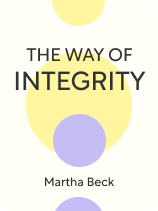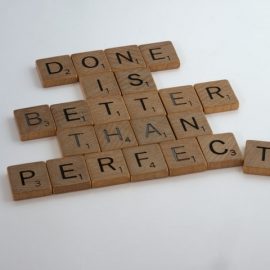

This article is an excerpt from the Shortform book guide to "The Way of Integrity" by Martha Beck. Shortform has the world's best summaries and analyses of books you should be reading.
Like this article? Sign up for a free trial here.
Can a lie feel like it’s true? How can you tell when something you believe is false? How can you recognize the truth?
Martha Beck argues that the only way to overcome the chronic misery of misalignment with your true self is through a four-stage process of realignment. The second stage is challenging your false beliefs and recognizing your inner truths.
Let’s unpack Beck’s methods for challenging your beliefs—exposing what’s false and uncovering what’s true.
Challenge Your Beliefs
Once you begin to recognize false beliefs, it’s time to start challenging your beliefs and overcoming them. Even though you might consciously understand that something isn’t true, it can still feel true, and it’s these feelings that you’ll have to change.
For example, one of the most common false beliefs people hold is that their value as a human is dependent on something external. They think they will be worthy of love only if they are successful, virtuous, or beautiful. You could ask these people whether these statements are true, and they will often tell you they are false. Yet nonetheless, many of us feel that statements like these are true—and suffer for it. We’ll cover Beck’s techniques for questioning false beliefs and recognizing your inner truth.
| How Strong Is Your Grip on Reality? Beck asserts that many of us believe things even though we know on a deeper level that they aren’t actually true. To some, this may sound as if she’s claiming that people are naturally dishonest or crazy. However, many psychologists assert that our grip on reality may not be as strong as we believe, simply because of how our brains work. The human brain requires an enormous amount of energy to run. This causes two distinct consequences. First, when forming memories, we often retain the minimum amount of information our brain thinks we need. This can make it more difficult to learn from our experiences. Second, our brains tend to rely heavily on autopilot: our habitual patterns of thought and perception. Therefore, once an idea about how the world works has become part of our default programming, dislodging this idea could take a lot of effort, particularly as our brains have to learn and develop new habits of thought. In light of these tendencies, we shouldn’t be surprised that someone may continue to hold onto a belief, even when they are repeatedly exposed to contradictory evidence. |
As you explore your mind’s forbidden zones, you discover false beliefs that caused you pain. The next step is to challenge and overturn these beliefs. Drawing on the work of self-help author Byron Katie, Beck offers two strategies for overturning false beliefs.
1. Ask yourself—can you be absolutely sure it’s true? While your false beliefs may feel intuitively plausible, it’s hard to be absolutely sure of something if, on some level, you know that it’s technically false. Asking if you are absolutely sure something is true often introduces the first crack of doubt into your belief. For example, let’s say you believe that you will never be happy. Ask yourself, can you be absolutely sure that you won’t ever be happy in your life? Not even once, for one second? If you can come up with just one tiny counterexample, then you can’t be absolutely sure.
2. Reverse the formula. Beck also recommends challenging false beliefs by inverting the statement. She recommends testing out new beliefs by switching out words for their opposites or reversing word order to come up with a new meaning. For example, if your false belief is, “I can’t be happy unless other people love me,” you might switch up to “I can be happy because I love other people.” If the reversed belief feels more true, then you might have stumbled on a way out of the false belief. In this next section, we’ll discuss how your emotions can help you to recognize the truth.
| Examining the Consequences of False Beliefs Beck draws on the work of self-help author Byron Katie (Loving What Is) in her techniques for challenging false beliefs. However, when pushing back on your false beliefs, Katie recommends thinking not just about the truth of these statements, but also about their consequences. She encourages you to ask yourself the following questions: 1. How does this thought benefit me? 2. How would I feel and behave without this thought? She argues that if you can directly see the ways your false beliefs are harming your life and holding you back, this can provide a strong boost of motivation to let go of these thoughts once and for all. |
Discover Your Inner Truths
After you challenge false beliefs, how do you recognize truths? Beck argues that you can distinguish between inner truths and false beliefs by paying attention to your body and moods. She identifies four qualities you experience while discovering an inner truth.
1. Physical relaxation: When you discover an inner truth, your body will relax. This is often because repression and misalignment take energy to maintain. You will experience a relaxing sense of physical relief as you let go of the need to control your emotions.
2. An “aha” moment: Recognizing truth will feel mentally like a sudden epiphany or insight. You may experience a sense of ideas clicking into place or a feeling of viewing your life from a new vantage point.
3. Feeling of openness: Recognizing truth often comes with a sense of feeling open. You will feel more receptive to new experiences, emotions, and sensations than before.
4. Feeling of freedom: You will experience a greater feeling of freedom to be yourself and choose your actions. As you let go of restricting false beliefs, new possibilities for your life will present themselves.
| Can You Recognize Self-Deception? Beck explains four ways to tell if you are recognizing your inner truth. However, it may be just as important to recognize when you are deceiving yourself. Psychologists argue that you can also recognize self-deception if you pay attention—though by definition, self-deception is hard to notice. Furthermore, many of the signs appear to be the inverse of Beck’s techniques for recognizing your truth. 1. Notice your body. Psychologists argue that self-deception will make you feel anxious and tense—the opposite of the physical relaxation you can expect to feel while recognizing your truth. 2. Notice your mind. Beck contends that recognizing your truth will give you an “aha” moment, whereas psychologists argue that self-deception will feel like a knee-jerk reaction—something that happens quickly and feels out of your control. 3. Notice your feelings. Beck argues that recognizing your truth produces feelings of openness and freedom. Psychologists explain that self-deception often produces feelings of shame—an emotion that makes people close down and withdraw into themselves—reducing their openness and constricting their freedom. |

———End of Preview———
Like what you just read? Read the rest of the world's best book summary and analysis of Martha Beck's "The Way of Integrity" at Shortform.
Here's what you'll find in our full The Way of Integrity summary:
- How to know if you're living in alignment with your true self
- How messages from our culture tell us to chase things we don't really want
- The four stages of realigning your life to find happiness






